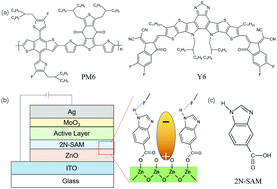In organic solar cells (OSCs), interlayers play a critical role in achieving good device performance and stability. However, the effects of hydrogen bonds between the interlayer and the active layer are less studied. In this work, a new interlayer modification strategy through hydrogen bonds is presented, and the interaction mechanism between the interlayer and the active layer is deeply analyzed. We use a new hydrogen-bond-induced interfacial material, 1H-benzimidazole-5-carboxylic acid (2N-SAM), as an interlayer and fabricate a high-power conversion efficiency of 16.03% in OSCs (compared to the 14.50% of pristine ZnO-based OSCs) based on PM6:Y6. Hydrogen bonds are formed between the N–H bonds of 2N-SAM and the F atoms of acceptor Y6, achieving a vertical phase separation in the active layer of the acceptor enrichment at the cathode and improving the transportation of electrons. Finally, the short-circuit current (JSC) is dramatically increased from 24.73 mA cm−2 to 27.08 mA cm−2. This demonstrates that hydrogen bonding between the interlayer and the active layer is a potential means to improve the performance of OSCs.
